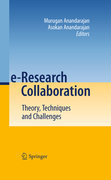
e-Research collaboration: theory, techniques and challenges
Anandarajan, Murugan
Anandarajan, Asokan
The shift of paradigm from collaborations of convenience to collaborations ofopportunity using Web 2.0 technologies is called Research 2.0. Research 2.0 is becoming a critical component in research management and collaboration and has led to the creation of new research networks such as MyNetResearch. Many universities are familiar with the concepts of Web 2.0 including Wikis, blogs, and social networking tools, but have not implemented these tools holistically in a research setting. Unfortunately, many researchers have difficulties either to understand how to implement the change in paradigm associated with onlinecollaboration, or else cannot convince the university administrators of the value of a research cyberinfrastucture. Universities are under increasing pressure to embrace the Research 2.0 paradigm in order to stay competitive, attractthe best students and faculty, publish, apply for research grants, and empower their stakeholders in all aspec Describes on how Web 2.0 technologies can help researchers collaborate With examples of web portals include MyNetResearch Discusses aspects of research management, research awareness, research networking, and research tools, which is critial for the success of the 21st century researcher INDICE: e-Research Collaboration: Theory.- e-Research Collaboration: Technologies.- e-Research Collaboration: Challenges.
- ISBN: 978-3-642-12256-9
- Editorial: Springer
- Encuadernacion: Cartoné
- Páginas: 280
- Fecha Publicación: 01/08/2010
- Nº Volúmenes: 1
- Idioma: Inglés
